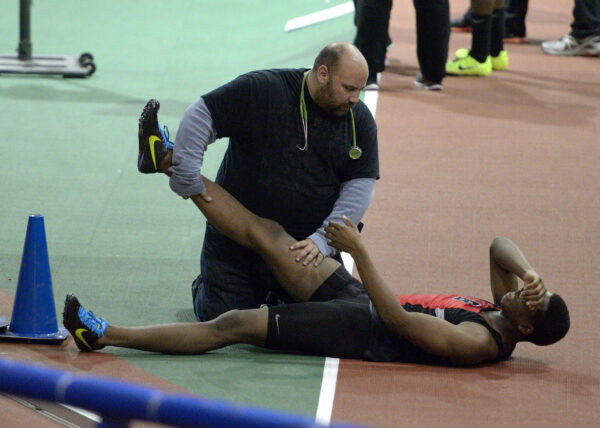Running is a very peaceful form of exercise without sudden unforeseen movements or violent collisions with other athletes. Despite this, runners are occasionally injured. The injuries you can incur as a runner can generally be divided into two main groups. These are acute injuries and congestion injuries. In What Is The Treatment For Pulled Muscle? we take a closer look at this type of running injury.

A Pulled Muscle
A pulled muscle refers to an injury in the muscle tissue, where the tissue breaks down as a result of too long or too much load. the extent of the injury ranges widely. With a modest injury, the symptoms disappear after a week.
The very severe tissue injury requires several months of rehabilitation before reaching full training strength again. Fortunately, the predominance of fiber injuries is among the minor fiber injuries.
The term ‘pulled muscle’ refers to a state and not to one particular injury and can therefore occur anywhere in the body. Of course, there are certain muscle groups that are strained more when running.
The muscles of the calf and hind thigh are by far the most common injury places of runners, and less frequent fiber injuries are seen in the muscles on the front of the thigh, the hip flexors, and the gluteal muscles.
What Is The Treatment For a Pulled Muscle – Causes And Symptoms

Muscles are build-up of many small muscle bundles, where each contains many muscle fibers. If parts of the muscle are torn over, we call it muscle tearing. If the extent of the injury is limited to some of the small muscle fibers, the injury is called a pulled muscle.
Treat pulled muscle – causes
In almost all fiber injuries, the injuries are caused by excessive use of the muscle. It can either be by excessive sudden force development of the muscle or by prolonged loading of the same muscle.
An excessive sudden vigorous muscle activation, which causes a fiber injury, is characteristic of the classic acute injury. The injury comes like lightning from a clear sky and is associated with a sharp pain.
Further running here will be painful. In larger fiber injuries, a bluish discoloration is often seen in the area after some time, which is the blood leakage from the injured muscle fibers. However, the fiber injury doesn’t only have to occur as a result of one powerful movement but can follow the course of an overload injury.
If the muscle doesn’t have enough time to rebuild itself after each run, the strength of the muscle tissue is degraded and small injury gradually occurs in the tissue. There will be increasing soreness and the muscle will feel tense, first after training and later also during training.
Treat pulled muscle – symptoms
However, the typical injury course is a mixture of overuse injury and acute injury. In the beginning, the runner experiences that the muscle is sore and tense after the run and possibly in the first minutes of the training.
If the tissue is overloaded, now only a moderately sudden muscle contraction is required before the individual fibers are ruptured. The injury is therefore immediately in the nature of an acute injury but is due to an overload of the tissue.

A rare way to incur a defect in the muscle fibers as a runner is by ‘striking’ the muscle. The fibers are not pulled apart here but are “crushed” instead. This can happen in a fall where it is typically the thigh that strikes a hard object.
Most people know the condition as a “wooden thigh”. Due to the pain, the muscle responds by tensing, and this tension is one of the last symptoms that disappear. With large fiber ruptures, you can sometimes feel a minor defect in the muscle.
In the case of very serious injuries, there is a definite partial muscle tearing. Here you will be able to both see and feel the defect in the muscle, and it will not be possible to use it. Improper training behavior is often one of the causes of a fiber injury.
A poor warm-up for example does not adequately prepare the muscles for the upcoming performance and insufficient recovery does not allow the muscles to regain their previous strength before it’s being loaded again.
The Best Treatment For a Pulled Muscle
A fiber rupture should be treated as an acute injury, ie. using the R.C.I.E.M principle – This abbreviation indicates the initials of the five basic elements for the treatment of an acute injury. The abbreviations are mentioned in order of priority and express rest, compression, ice, elevation, and mobilizing.
We should also look at whether there should be certain conditions underlying the fiber injury. Improper training behavior is one of the classic reasons why the treatment i.a. consists of a report of the amount of training, training progression, warm-up and warm-up rituals and performance of stretching exercises.
Best treatment for a pulled muscle – after the acute phase
Once the acute phase is over, a very gentle massage will lower the muscle tension and eliminate possible fluid accumulation. Later in the course, more in-depth massage can be used to loosen the stiff scar tissue that has typically been formed.
Both early-stage massage and deep transverse massage should only be performed by established therapists. Ultrasound will have a tissue massaging effect and is also relevant when blood clots need to be removed. To begin with, stretching exercises are performed very carefully and within the pain limit.
Exercise and physical exercise, in general, must not exceed the pain threshold and a return to normal training volume should take place gradually. If you have previously suffered a fiber rupture, the probability of getting a similar injury again is much higher than before.
This is partly due to the inflexible scar tissue formation and because the muscle is typically weaker than before. These are conditions that emphasize the importance of serious rehabilitation after fiber rupture, where both flexibility and strength in the muscles involved are crucial.

RCIEM principle Treatment
As always, this advice is very general in nature and may not be appropriate for all injuries and all people all the time. As mentioned Acute sports injuries are the type of injuries that occur suddenly. This is typically due to stepping incorrectly, falling or colliding with another participant.
Such an injury can vary greatly in severity from a slight sprain to severe ligament injuries, torn muscle fibers and tendons, or bone fractures. Acute injuries must be treated immediately according to the RCIEM principle, and in severe cases examined in the emergency room.
Treatment of acute injury
The RCIEM principle can also interprets as:
R: Stop the activity immediately.
C: Compression – the injured site is bandaged with an elastic bandage to prevent excessive bleeding and fluid accumulation, thus shortening the healing period. Use the compression for the first few days. However, not too tight so that blood flow is shut off.
I: Ice – cool the injured area with an ice pack, it soothes the swelling and pain in the area.
E: Elevation – the injured body part should be kept above heart level as often as possible for the first 24 hours to reduce swelling and relieve the injured area.
M: Mobilization – it is important to start moving joints, tendons, and muscles in the injured area as soon as it can be done without provoking further pain and swelling. It promotes healing and removes swelling.
Overload injuries are caused by prolonged incorrect or excessive impact on the body. The first signs of an incipient sports injury due to overload can be stiffness in the joints in the morning, deep and murmurous pain, or pain in the body – in addition to normal training soreness – when it has cooled down after sports activity.
It can result in inflammatory conditions in tendons or mucous sacs or possibly. end up with fatigue fractures in a bone.
Overload injuries often require relief for a period and possibly rescheduling the workout until the symptoms are gone and regular exercise can be resumed slowly. Sports injuries due to overload can be very long-lasting and possibly require medical or medical treatment.

Final Thoughts
The treatment and rehabilitation after any sports injury are very important, so the injury break is as short as possible. Here, the physiotherapist can help find any. cause the occurrence of the injury, help the healing process in the tissue along the way as well as relieve the pain.
The physiotherapist can guide you with appropriate exercises to rebuild the tissue and prevent injuries. So you can run again at full strength over time.
I hope you like this review and if you have any questions about the topic or want to leave your own Personal review, please leave a comment below.
[faq-schema id=”5344″]

